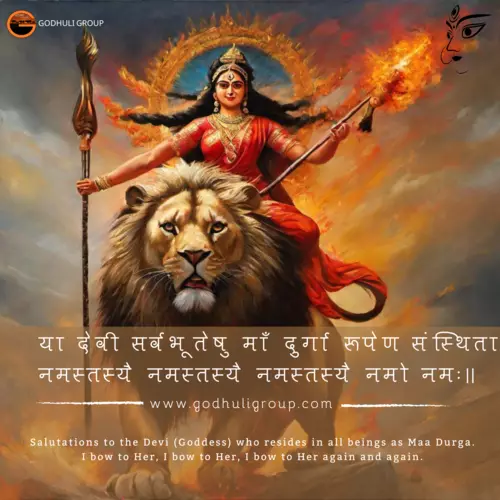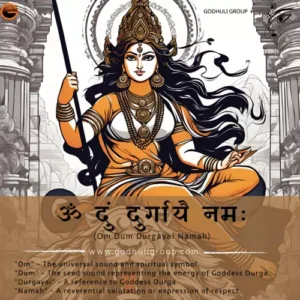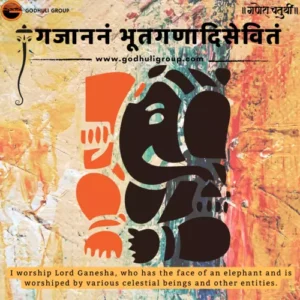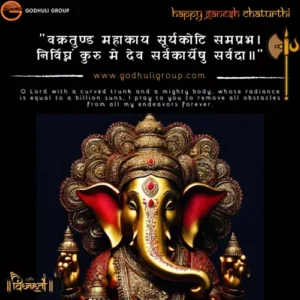The shloka “या देवी सर्वभूतेषु माँ दुर्गा रूपेण संस्थिता। नमस्तस्यै नमस्तस्यै नमस्तस्यै नमो नमः॥” is a beautiful and spiritually significant verse dedicated to Goddess Durga. In this blog, we will explore this shloka’s profound meaning and significance, shedding light on the essence of devotion, reverence, and the universal presence of the Divine Mother. What is the meaning of the devi Durga Shloka या देवी सर्वभूतेषु माँ दुर्गा रूपेण संस्थिता। , नमस्तस्यै नमस्तस्यै नमस्तस्यै नमो नमः॥.
What is the meaning of devi Durga Shloka

Understanding the Shloka:
1. “या देवी सर्वभूतेषु” (Yā Devī Sarvabhūteṣu):
• “या” (Yā) refers to “She who.”
• “देवी” (Devī) means goddess or divine feminine.
• “सर्वभूतेषु” (Sarvabhūteṣu) signifies all living beings.
This opening phrase acknowledges the presence of the divine feminine, Goddess Durga, within the hearts and souls of all living beings. It underscores her omnipresence, indicating that she is not confined to any particular place or form.
2. “माँ दुर्गा रूपेण संस्थिता” (Māṁ Durgā Rūpeṇa Saṁsthitā):
• “माँ” (Māṁ) is an affectionate term for mother.
• “दुर्गा” (Durgā) refers to the specific form of the goddess as Durga, the fierce and protective aspect.
• “रूपेण” (Rūpeṇa) means in the form of.
• “संस्थिता” (Saṁsthitā) signifies being established or situated.
This part of the shloka recognizes Goddess Durga as the Divine Mother who is firmly established in the form of Durga. It highlights her role as a protector and the one who eliminates obstacles and difficulties in the lives of her devotees.
3. “नमस्तस्यै नमस्तस्यै नमस्तस्यै नमो नमः” (Namastasyai Namastasyai Namastasyai Namo Namaḥ):
• “नमस्तस्यै” (Namastasyai) is an expression of salutation and reverence.
• “नमो” (Namo) is a humble way of saying “I bow” or “I salute.”
This concluding part of the shloka is a heartfelt expression of respect and devotion, emphasizing the profound reverence of the devotee. The repetition of “namo” and “namastasyai” three times signifies the depth of devotion and the intensity of the connection with Goddess Durga.
Significance of the Shloka:
1. Universal Presence: The shloka beautifully conveys the idea that the Divine Mother, in the form of Goddess Durga, is omnipresent and resides within all living beings. This recognition of her universal presence fosters a sense of interconnectedness and unity.
2. Maternal Love and Protection: Goddess Durga is often regarded as the loving and protective mother who shields her devotees from harm and adversity. The shloka highlights her role as the caring and nurturing Divine Mother.
3. Devotion and Surrender: The repetition of “namo” and “namastasyai” underscores the importance of surrender and devotion in one’s spiritual journey. It serves as a reminder that genuine devotion is a powerful way to connect with the divine.
Conclusion:
The shloka “या देवी सर्वभूतेषु माँ दुर्गा रूपेण संस्थिता। नमस्तस्यै नमस्तस्यै नमस्तस्यै नमो नमः॥” encapsulates the essence of devotion, reverence, and the universal presence of Goddess Durga. It is a powerful reminder of the loving and protective nature of the Divine Mother, inviting devotees to bow in heartfelt reverence and seek her blessings and guidance in their lives. This shloka serves as a profound source of spiritual inspiration for those on the path of devotion in Hinduism.



